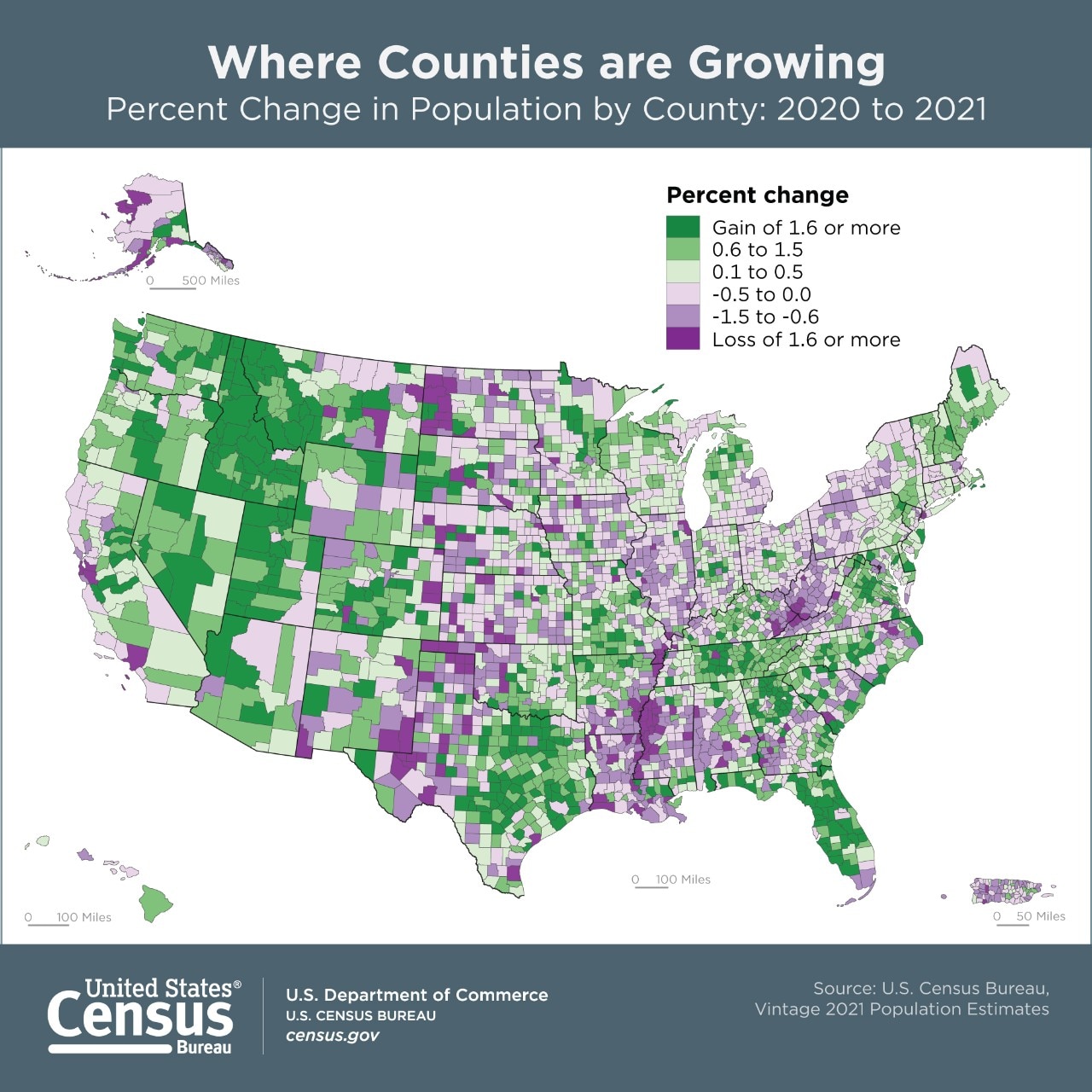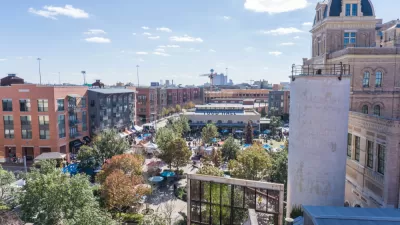The nation's three largest cities lost a combined 700,000 residents between July 2020 and July 2021—the fastest growing regions in the country couldn't keep up. The new data is being framed in the media as evidence of the decline of cities.

The U.S. Census Bureau released new population data on March 24, revealing unprecedented trends and a stark reversal from just ten years ago.
According to a press release announcing the Vintage 2021 population estimates, "More than 73% (2,297) of U.S. counties experienced natural decrease in 2021, up from 45.5% in 2019 and 55.5% in 2020."
"Natural decrease occurs when there are more deaths than births in a population over a given time period. In 2021, fewer births, an aging population and increased mortality – intensified by the COVID-19 pandemic--contributed to a rise in natural decrease," continues the press release.
Media coverage of the new census data was widely available on the day of the data drop, led by an article by Robert Gebeloff, Dana Goldstein, and Winnie Hu for the New York Times that headlined the country's overall slow rate of population growth and the decline of population in the nation's three largest cities—Los Angeles, New York, and Chicago—in addition to other superstar cities like San Francisco.
The article describes the trends evident in the Census data as complex enough to defy simple explanation:
The pandemic played a role, as the number of people dying rose substantially and many Americans left cities for smaller places. But experts say that skyrocketing housing costs were also to blame, and that some of the changes are a continuation of fundamental shifts in American demographics that began before the pandemic, such as the steadily falling birthrate and steep drop in immigration.
Here's how the New York Times article summarizes the geography of pandemic population trends:
New York, Los Angeles, Chicago and San Francisco lost a total of over 700,000 people from July 2020 to July 2021, according to the Census Bureau. Meanwhile, Phoenix, Houston, Dallas, Austin and Atlanta gained more than a total of 300,000 residents. And there was also substantial growth in some rural areas and smaller cities like Boise, Idaho, and Myrtle Beach, S.C.
Also, the New York Times presents the data as a reversal of the trend toward urban growth that defined much of the past decade since the Great recession:
The pattern is a notable contrast from a decade ago, when large cities were growing, bolstered by a decades-long boom in immigration and the rising popularity of urban living. At that time, most of the counties losing population were rural or experiencing economic decline.
Richard Florida took to Twitter to provide insight into the data, and the New York Times' coverage of the data, and noted that while the largest cities are losing the most residents, the next tier of large cities are gaining residents.
"To me the big takeaway of the this [sic] story on population is that growth is strongly concentrated in a group of pretty large metros like 6-7 million people large like Dallas, Houston & Atlanta as well as Phoenix and Austin," writes Florida on Twitter. "This should not be all that surprising, and it suggests "urbanization" is still at work. It is not small tiny places sucking up all the growth. It is the 2nd largest places outside of NY, LA and Chicago."
Another article by Mike Schneider for the Associated Press found its way into various local daily news sites. For the Chicago Tribune, Schneider's article is headlined by Chicago's population loss. For the Houston Chronicle, Schneider's article is headlined by Houston's population growth.
The University of North Carolina at Chapel Hill also provides insight into the new Census data specific to that state's growth. "North Carolina grew by 112,000 people or 1.1% between April 1, 2020, and July 1, 2021, faster than the national rate of 0.1%. According to the estimates, 73 North Carolina counties grew in the 15 months following the Census," according to the article by Rebecca Tippett.
FULL STORY: Over Two-Thirds of the Nation’s Counties Had Natural Decrease in 2021

Study: Maui’s Plan to Convert Vacation Rentals to Long-Term Housing Could Cause Nearly $1 Billion Economic Loss
The plan would reduce visitor accommodation by 25,% resulting in 1,900 jobs lost.

North Texas Transit Leaders Tout Benefits of TOD for Growing Region
At a summit focused on transit-oriented development, policymakers discussed how North Texas’ expanded light rail system can serve as a tool for economic growth.

Using Old Oil and Gas Wells for Green Energy Storage
Penn State researchers have found that repurposing abandoned oil and gas wells for geothermal-assisted compressed-air energy storage can boost efficiency, reduce environmental risks, and support clean energy and job transitions.

Santa Barbara Could Build Housing on County Land
County supervisors moved forward a proposal to build workforce housing on two county-owned parcels.

San Mateo Formally Opposes Freeway Project
The city council will send a letter to Caltrans urging the agency to reconsider a plan to expand the 101 through the city of San Mateo.

A Bronx Community Fights to Have its Voice Heard
After organizing and giving input for decades, the community around the Kingsbridge Armory might actually see it redeveloped — and they want to continue to have a say in how it goes.
Urban Design for Planners 1: Software Tools
This six-course series explores essential urban design concepts using open source software and equips planners with the tools they need to participate fully in the urban design process.
Planning for Universal Design
Learn the tools for implementing Universal Design in planning regulations.
Ascent Environmental
Borough of Carlisle
Institute for Housing and Urban Development Studies (IHS)
City of Grandview
Harvard GSD Executive Education
Toledo-Lucas County Plan Commissions
Salt Lake City
NYU Wagner Graduate School of Public Service






























